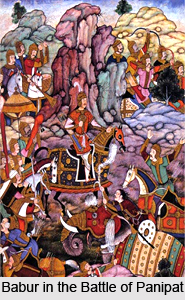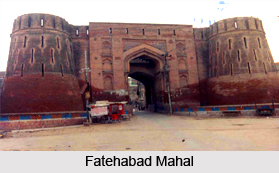 History of Fatehabad District narrates that with the decline of Mughal Empire, the tract comprising the present district came under the control of Marathas. The whole territory of Delhi, of which the tract formed part, was ceded by the Marathas to the British in 1810. The Delhi territory was divided into two districts, Delhi, directly under the resident and the outlying district including Hansi, Hisar, Sirsa, Rohtak, Panipat and Rewari under the immediate charge of an Assistant. Again in 1819, the territory of Delhi was divided into three districts namely the central district which included Delhi, southern district comprising Rewari and north-western district comprising Panipat, Hansi, Hisar, Sirsa and Rohtak.
History of Fatehabad District narrates that with the decline of Mughal Empire, the tract comprising the present district came under the control of Marathas. The whole territory of Delhi, of which the tract formed part, was ceded by the Marathas to the British in 1810. The Delhi territory was divided into two districts, Delhi, directly under the resident and the outlying district including Hansi, Hisar, Sirsa, Rohtak, Panipat and Rewari under the immediate charge of an Assistant. Again in 1819, the territory of Delhi was divided into three districts namely the central district which included Delhi, southern district comprising Rewari and north-western district comprising Panipat, Hansi, Hisar, Sirsa and Rohtak.
Further, according to the history of Fatehabad District, in 1820 the north-western district was sub-divided into two separate districts, northern and western. The western district included Bhiwani, Hansi, Hisar and Sirsa and its headquarters were at Hansi. In 1824, Rohtak which had previously been under the western district was constituted into a separate district to which Bhiwani was transferred. The headquarters of the district was shifted from Hansi to Hisar in the year 1832. Moreover, the district was then divided into four tehsils of Hisar, Fatehabad, Hansi and Tosham. In 1837, Ratia and Tohana Parganas were added to Hisar District and were formed into a separate tehsil of Tohana. Sirsa tract was detached in 1837 from Hisar district and placed under a separate officer. Pargana of Darba and Pargana of Rori were transferred to Bhattiana in 1838 and 1847 respectively. In 1852, Pargana of Ratia was transferred from Tohana tehsil to Fatehabad tehsil and Barwala Pargana was detached from Hisar tehsil and was formed into a separate tehsil of Barwala along with Tohana.

The whole of Delhi territory along with districts of Bhattiana and Hisar were transferred to Punjab in 1858 and the district of Bhattiana was re-named as Sirsa District. History of Fatehabad District also states that in 1861, Bhiwani tehsil was detached from Rohtak and added to Hisar District. Tosham tehsil was added to Bhiwani tehsil in the same year. On November, 1884, Sirsa tehsil with 199 villages and 126 villages of Dabwaii tehsil was added to Hisar District. In 1889, 15 villages were transferred from Kaithal tehsil to Fatehabad tehsil. Barwala tehsil containing 139 villages was abolished in the year 1891 and its area was distributed between three contiguous tehsils, 13 villages going to Hansi, 24 to Hisar and 102 to Fatehabad.
In 1923, the Tohana sub-tehsil was transferred from Fatehabad to Hisar tehsil. No transfer of territory to or from the district took place till the passing of the Provinces and States (Absorption of Enclaves) Order, 1950, by which the erstwhile princely state of Loharu was merged in the district and 15 villages were taken out of Hisar District and added to Bathinda District. In 1962, three villages were transferred from Dadri tehsil of Mahendragarh District to Bhiwani tehsil. Further, the entire area of the district was included in the new state of Haryana on November 1st, 1966. In 1968, Sirsa tehsil was bifurcated into Sirsa and Dabwali tehsil and Bhiwani was bifurcated into Bhiwani and Loharu. In 1969, a village was transferred from Dadri tehsil to Bhiwani tehsil.
These administrative arrangements continued till 1972 when whole of Loharu and Bhiwani tehsils, 32 villages of Hansi and 17 villages of Hisar tehsils were excluded and included in the newly formed Bhiwani District. Tohana sub tehsil was upgraded to a tehsil in 1972. In 1974, four villages were transferred from Hansi to Hisar tehsil, 18 villages from Hisar to Hansi tehsil, two villages from Hisar to Fatehabad tehsil, 18 villages from Tohana to Fatehabad tehsil, nine villages from Fatehabad to Tohana tehsil, 10 villages from Fatehabad to Hisar tehsil, 3 villages from Dabwali to Sirsa tehsil and one village from Hansi tehsil to Jind tehsil of Jind district. In 1975, Sirsa and Mandi Dabwali tehsils were excluded from the district and a new district of Sirsa was carved out. Thus, by the end of 1978, the Fatehabad part of Hisar district comprised 254 villages, divided between tehsils of Fatehabad 166, and Tohana 86. Fatehabad District came into existence in the year 1997 by carving out Hisar District.






